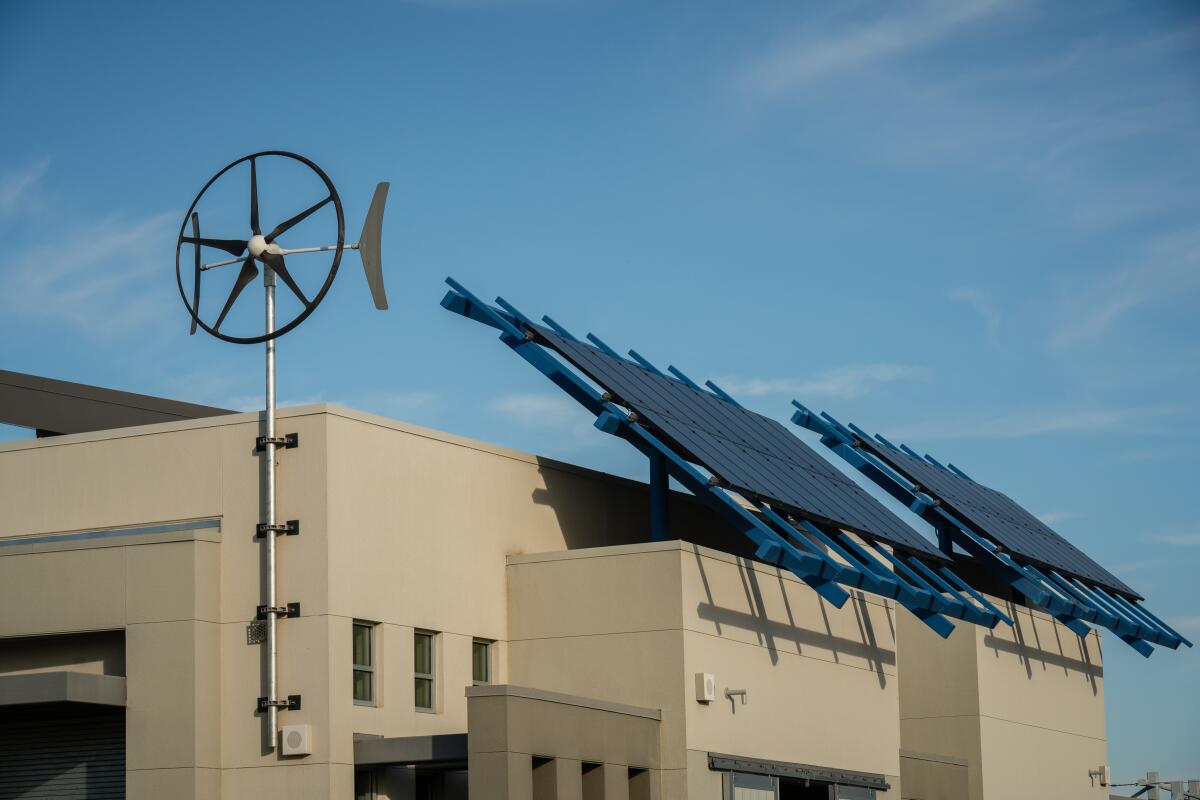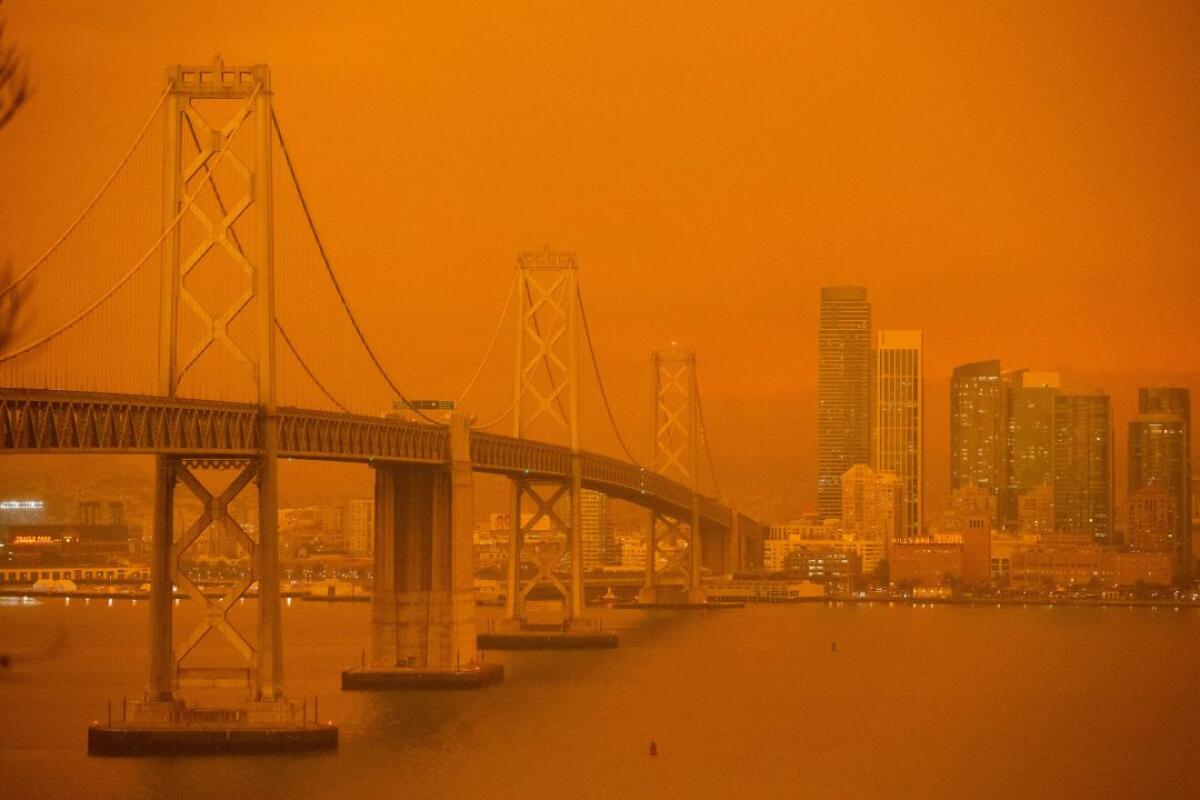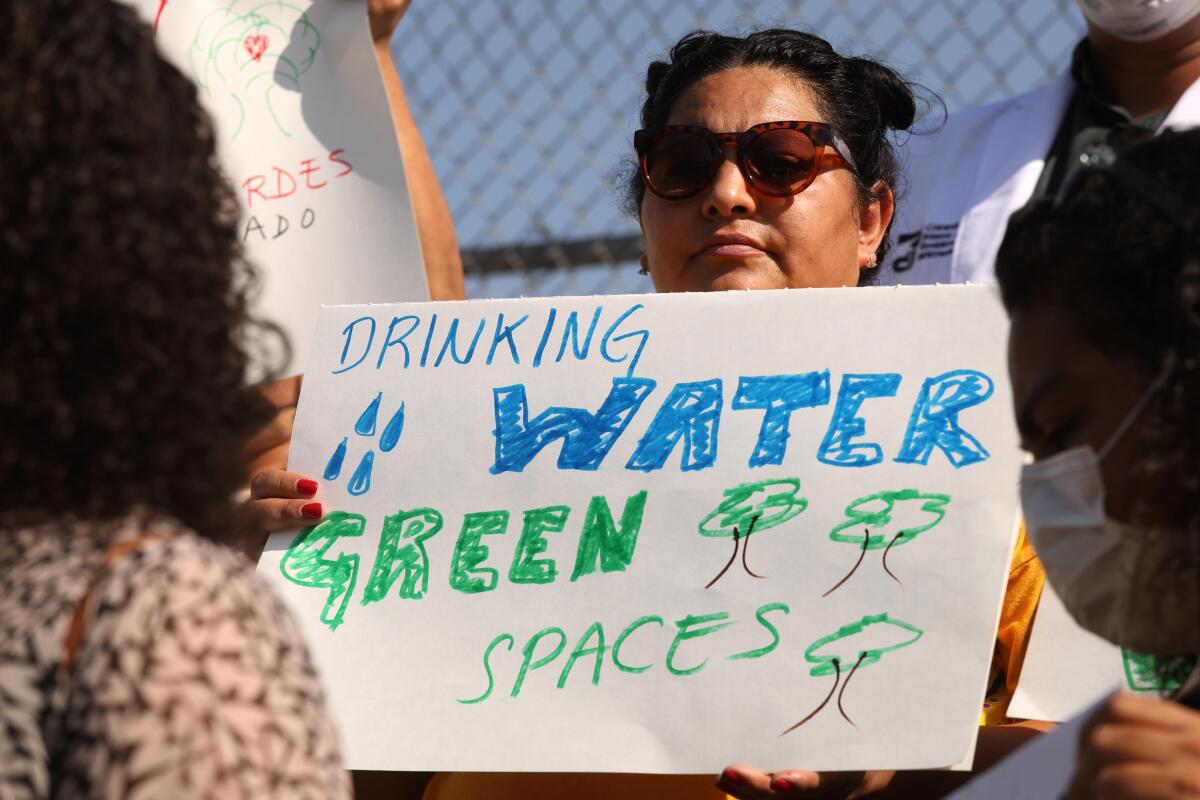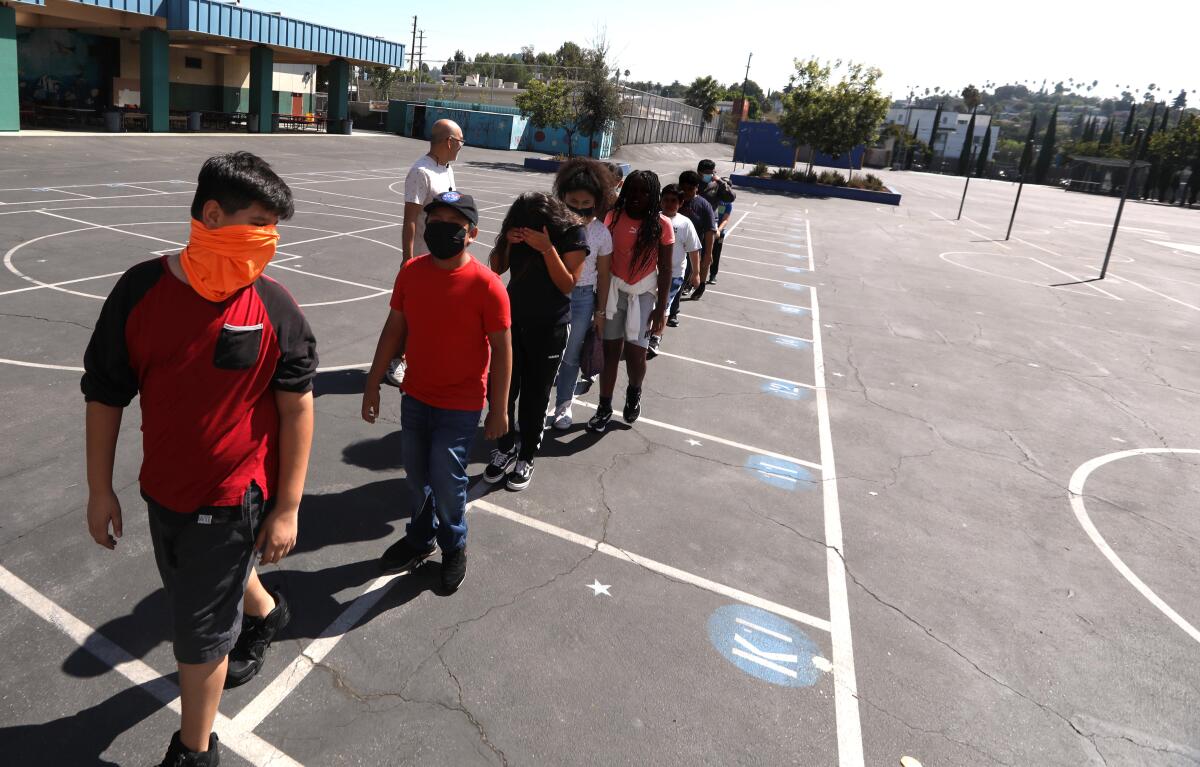Why we can’t solve the climate crisis without schools — and teachers

- Share via
This story was originally published in Boiling Point, a weekly newsletter about climate change and the environment. Sign up here to get it in your inbox.
When wildfire smoke blocked the sun and turned the sky orange above the San Francisco Bay Area in September 2020, Andra Yeghoian’s two young children, ages 3 and 5, were scared. And they had questions: What was going on? Was this normal?
Yeghoian did her best to explain and to comfort them.
“I can’t not talk about climate change with my kids,” she said. “It’s the same for teachers with their students.”
Yeghoian is one of the lead authors of a new report — released Thursday and shared exclusively with The Times — exploring how K-12 schools can educate students about climate change, while contributing to climate solutions themselves.
It’s a fascinating read, full of useful ideas for teachers, lawmakers, government agencies, school districts and kids. It was written by university researchers and staffers at a variety of nonprofits, advocacy groups and other organizations, with funding from the Schmidt Family Foundation, which is backed by former Google Chief Executive Eric Schmidt and his wife, Wendy.
The report’s basic argument is that schools are uniquely positioned to help solve the climate crisis.
California’s elementary and secondary schools have a huge physical footprint, covering 125,000 acres of ground and 730 million square feet of buildings. That means they’re prime spots for solar panels, batteries, heat pumps, electric buses and efficiency measures that can reduce the need for fossil fuels. The report estimates that K-12 public schools produce 9% of all carbon dioxide pollution from the state’s nonresidential buildings — not counting pollution from cars and buses going to and from schools.
Children, meanwhile, spend about 180 days a year on campus, playing, eating and learning — not to mention breathing.
The wildfire smoke that increasingly fills California’s skies as temperatures rise isn’t just scary for kids — it’s bad for their lungs and can hamper their ability to learn. The report cites recent research linking wildfire smoke with lower test scores.

Smoky air can also fuel respiratory illness and keep kids out of the classroom with asthma attacks. In 2007 alone, California K-12 students missed 1.6 million school days due to asthma. The report’s authors estimate that by midcentury, there could be a 50% increase in children’s hospitalizations for respiratory issues as global warming fuels bigger, more destructive fires.
For Lisa Patel, a Stanford University pediatrician and one of the report’s lead authors, it was COVID-19 that first shined a light on the importance of clean air in the classroom. Her daughter started kindergarten while campuses were shut down in 2020, prompting her to research how schools could reopen safely. She learned that ventilation and air conditioning systems are crucial for filtering out viruses, as well as dangerous particles from wildfire smoke. But many schools don’t have them.
Students who miss time in the classroom and fall behind learning to read, Patel told me, are less likely to graduate from high school, and in turn more likely to grapple with poverty and lack of health insurance. It’s especially difficult for children from low-income communities with fewer resources — many of whom are children of color — to catch up once they fall behind.
“Disrupting a child’s access to learning has myriad affects, including on their health,” Patel said. “We’re living through climate change right now, and we know a lot of what’s coming. There’s no excuse to not prepare our buildings.”
Wildfires aren’t the only climate challenge for schools and students. Heat can be devastating, too.
Patel saw the dangers firsthand during last year’s Labor Day weekend heat wave, when she had two 24-hour shifts. She called them “the worst two shifts I’ve worked in a decade.” Temperatures reached 116 degrees outside her hospital. She was called to several deliveries where laboring mothers had fevers or other complications, and admitted several infants into intensive care.
“In retrospect, I don’t know if those moms had a true infection or if they just got overheated,” Patel said.
Schools face their own versions of those problems. Extremely hot days — or climate-fueled power outages — can force them to shut down if they don’t have air conditioning or backup power sources on campus, such as solar panels and batteries.
Heat can make it harder to learn, too. The report cites research finding that hot days “can impair cognitive functioning and worsen academic performance,” especially for low-income students and students of color less likely to have AC at their schools.
But here’s where we turn to solutions. Building schools that run on renewable energy and provide shelter from heat and smoke, the report argues, will not only protect children — it can also support entire communities struggling to deal with climate change impacts and help prepare young people to thrive in a world that’s only getting hotter.

I talked with Jeff Vincent, co-founder of UC Berkeley’s Center for Cities and Schools and another of the report’s lead authors. He told me that many of California’s 10,000 public schools already serve as community centers during climate disasters, when there’s nowhere else to go. Schools have served meals to first responders battling fires and storms, given people displaced by extreme weather a place to sleep, and helped heat-stressed kids and their families cool down — if they have air conditioning, that is.
It’s crucial, Vincent said, to make sure that all schools have the modern, upgraded facilities needed to serve those roles — and not just campuses in wealthier neighborhoods, where it’s easier to raise money for costly infrastructure projects via bonds.
“Other states provide more funding for lower-wealth schools to fix up their facilities,” he said. “California doesn’t really do that.”
In the future envisioned by the researchers, schools could serve as community assets during “normal” times, too. They’re often some of the only open areas in park-poor neighborhoods, but many of them have more asphalt than green space.
Replacing pavement with fields, gardens and trees could help reduce neighborhood temperatures and keep carbon out of the atmosphere, while giving students and local residents a place to play and relax, safe from the health dangers of heat.
The report’s authors are urging state lawmakers and Gov. Gavin Newsom’s administration to develop a master plan for climate-resilient schools — and provide substantial funding to back it up. They cite estimates that over the next decade, local and state government must invest about $150 billion in school facilities across California, about double current spending levels. The money would go toward badly needed infrastructure upgrades, including but not limited to clean energy and climate projects.
It’s especially important for the state to direct climate money to schools in low-income areas, Vincent said, because those are the places where people are at greatest risk from extreme heat, pollution and other consequences of burning fossil fuels.
“You could see a scenario where all of the most climate-resilient schools in the state were in the 100 highest-climate-hazard areas in the state. That would be an interesting approach,” he said.

There’s another aspect of the report I haven’t talked about yet, but it’s no less important. That’s climate education.
As far as the authors are concerned, one of the most valuable steps the Golden State can take to combat global warming would be training its teachers to incorporate climate into their lessons and preparing students for jobs in the green economy.
It’s a cause near and dear to Yeghoian’s heart. As a high school English and social studies teacher more than a decade ago, she made environmental history a regular feature of her lessons and helped students write papers on environmental topics.
As the full-time sustainability director at a private high school in Oakland — and more recently as environmental literacy and sustainability coordinator at San Mateo County’s Office of Education — Yeghoian helped other educators do the same.
“I don’t think there’s a real strong hope for humanity without K-12 schools being on board,” she told me. “If we keep on graduating generation after generation that is not environmentally literate, it’s going to be really hard.”
Yeghoian is now chief innovation officer at Ten Strands, a San Francisco-based nonprofit that works to improve environmental education. Her experience is that students whose teachers bring climate change to the classroom are grateful for the chance to engage with an issue that’s already giving many of them anxiety. Climate education, she said, can be empowering.
“They can shift from feeling despair and apathy to feeling hope,” she said. “They can do something about this.”

California lawmakers have already directed a few million dollars toward creating model lessons for teachers on climate change and environmental justice, much as they’ve already taken limited steps in line with some of the report’s other recommendations. What’s crucial now, the authors say, is for Newsom and the state Legislature to scale up those efforts dramatically.
At least one legislator is already listening.
Jonathan Klein — a co-founder of the nonprofit UndauntedK12 and another of the report’s lead authors — pointed me to Senate Bill 394, introduced last month by Sen. Lena Gonzalez (D-Long Beach). It’s a “spot bill” still waiting to be filled out with details. But the goal is clear: to “require the creation of a master plan for achieving sustainable and climate-resilient school facilities.”
Young people aren’t satisfied hearing from adults that the climate crisis is a problem for their generation to solve, Klein said, when adults need to take the lead now, before it’s too late. Even after President Biden signed major climate legislation last year, Klein told me, he and his wife heard from their teenage kids that the grown-ups in charge still weren’t doing enough.
“They’re asking us for more record-scratch moments in terms of how we’re investing,” he said.
Bringing solar panels, heat pumps and electric buses to schools could help show students that their parents’ generation is serious about building a better world for them — while also giving students a climate learning laboratory, the report argues.
Teachers could use those clean energy systems to bring environmental lessons to life. They could also build classes around school air-quality monitors, plant-based meals served to students and on-campus gardens seeded with native trees and plants.
Is this vision for climate education likely to come to pass in our lifetimes, let alone the next 10 or 15 years?
It would certainly require a paradigm shift. But then again, so will sustaining a habitable planet. I choose to be optimistic.
ONE MORE THING

This week, the liberal watchdog group Media Matters for America released its annual report on climate change coverage by broadcast TV networks — namely ABC, CBS, NBC and Fox. The findings are at once encouraging and frustrating.
The networks collectively spent 1,374 minutes, or nearly 23 hours, reporting on climate across their morning and evening news broadcasts and Sunday morning political shows in 2022 — a record high in the decade since Media Matters started keeping track.
More climate coverage is a good thing. At the same time, 1,374 minutes was just 1.3% of the broadcast networks’ journalism last year — not much for an existential global threat. They spent 107,000 minutes covering other stuff, Media Matters noted.
A few other nuggets stuck out to me. Extreme weather was a big driver of coverage, appearing in 41% of last year’s 554 climate segments. But the networks largely missed the ball on the federal Inflation Reduction Act, with Media Matters writing that “the vast majority of coverage ... failed to detail the climate implications of the historic $369 billion allocated for climate action.”
Broadcast reporters also mentioned “fossil fuels” as the cause of global warming in just 8% of climate change segments.
I commend the TV journalists who are taking climate change seriously. I hope their bosses will get with the program soon.
That’s all for today. We’ll be back in your inbox next Thursday. If you enjoyed this newsletter, or previous editions, please consider forwarding it to your friends and colleagues. For more climate and environment news, follow @Sammy_Roth on Twitter.
Toward a more sustainable California
Get Boiling Point, our newsletter exploring climate change, energy and the environment, and become part of the conversation — and the solution.
You may occasionally receive promotional content from the Los Angeles Times.




